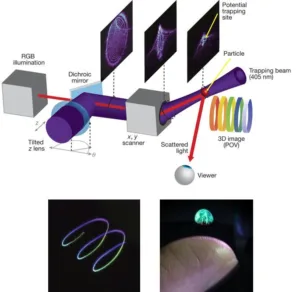A team of researchers led by Assistant Professor Daniel Smalley of the ElectroHolography Research Group within the Electrical and Computer Engineering Department at Brigham Young University (Provo, UT) is developing a means for “using light to print full color graphics into thin air.”
The researchers call the type of display technology that they have created a free space volumetric display. The device itself is called an Optical Trap Display. The display creates luminous image points in space and is based on photophoretic optical trapping.
A recent article by the team on this topic is entitled “A photophoretic-trap volumetric display.” It was published in Nature volume 553, pages 486-490 (25 January 2018). A copy of the article is available for purchase on-line and can be found here.
This display works by using a set of almost invisible laser beams to isolate a tiny cellulose particle in a photophoretic trap created by “spherical and astigmatic aberrations.” The laser light evenly heats the particle. This, in turn, enables the researchers with the ability to push and pull the particle. As the trap is scanned moving both the trap and the particle through a volume of space, the particle is illuminated with red, green and blue light. The image point thus created has a size of about ten microns.
Human vision cannot separately distinguish images presented at a rate faster than about 10 per second. As a result, by moving the particle sufficiently fast, persistence of vision produces a trajectory that appears as a solid line.
In their article, the researcher explain that “In simple terms, we’re using a laser beam to trap a particle, and then we can steer the laser beam around to move the particle and create the image.”
The resulting three dimensional image seems to hang in free space and can be viewed from any angle. In addition, the image is claimed to have a large color gamut, present fine detail and have low apparent speckle.
The top portion of the figure below illustrates the configuration of the optical system used in the Optical Trap display. The bottom portion of the figure contains two examples of graphics presented by the display system.
Top: Configuration of the Optical Trap Display Bottom: Illustrations of graphical objects produced by the Optical Trap Display.
At this time, the Optical Trap Display can only create images that are very small. This point is emphasized by the choice of figure presented in the lower right hand portion of the illustration above. The researchers have expressed the belief that, in the future, it will be possible to create larger images.
A video at the end of this article explains and demonstrates the operation of the Optical Trap Display.
The researchers point out two features claimed to be unique to free space volumetric displays:
- They are not subject to clipping. “Clipping restricts the utility of all three dimensional displays that modulate light at a two dimensional surface with an edge boundary.”
- They are capable of producing image geometries that are currently unobtainable with holographic and light field technologies. Specific mention is made of long throw projections, tall sandtables and wrap around displays.
Attempting to put their current technology development into proper context, the researchers comment that “While previous researchers outside of BYU have done related work to create volumetric imagery, the researchers claim that their recent work is the first to use optical trapping and color effectively.” -Arthur Berman
Brigham Young University, Daniel Smalley, 801-422-4343, [email protected]

